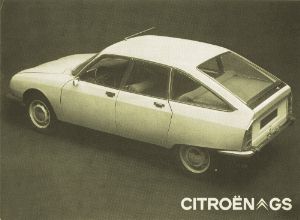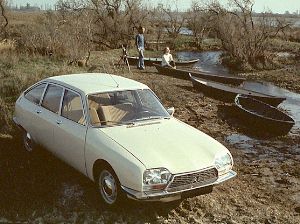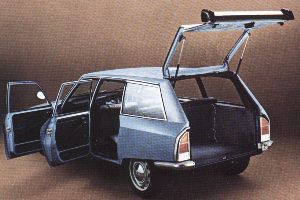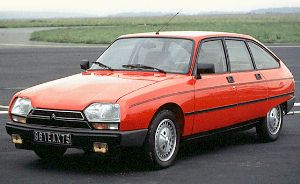|
|
|
 |
 |
|
|
|

|
The CitroŽn GS was presented in 1970 and became quickly in a representation car medium size. Also it compited for Cars of the Year Award with the new CitroŽn SM, presented that year too. By any standards, the GS was an audacious and advanced project in technical and estheic ways. The hydropneumatic suspension and the powered brakes of the DS, plus an aerodinamic body and a powerfull and economic engine resulted in a interesting and dense car which was over the rest of the cars in the market. Were GS's contemporary: the Renault 12, which was launched in 1969; the Fiat/Seat 124 and since 1974 its evolution, the Fiat/Seat 131. |
|
The GS is impulsed by a boxer and air cooled engine with four cylinders and overhead camshafts. The engine capacity was limited in 1015cm3 to fit within the 6CV tax bracket, and 1222cm3 for luxiorus and sports versions. This engine is so economic and simple like others CitroŽns, and thrives on revs like a miniature Porsche or motorcycle engine. Because its aerodinamic body, the GS needs only 55CV (1015cm3 engine) to reach a top speed of 147 Km/hs (92 mph). Also the GS mounted discs on all four wheels, inboard at the front and on the wheels at rear. The interior is futuristic, the dash featured a "cyclops eye" speedo and boomerang shaped tacho plus a multiplicity of warning lamps. The gearchange is mounted at floor and the parking brake is an horizontal bar fitted in the middle of the dashboard. |
 |

|
The GS was initially launched in two trim levels: Confort and Luxe. In 1972, the Break version was presented and since 1973 a 1222 cm3 (60 CV) engine would be available. In 1974, a new GS version was presented with a Rotary Wankel engine. Next year, the Pallas version was launched. It have a luxurious interior based on the Pallas trim used in the CitroŽn DS Pallas. This version was only available with 1222cm3 engine. Sports versions were first represented by the GS X and then by the GS X2. Since 1979, the GS X3 replaced GS X2. The GS X3 uses a 1299cm3 engine that offer 65 CV and it reach a top speed of 160 Km/hs (100 mph). The sports versions were fitted with sports seats and long range driving lamps. Also they were available with a choice of normal or "short" gearboxes which have closer ratios and improved acceleration over the standard box. In 1978, the 1015 cm3 engine grew up until 1129 cm3 developing 56 CV. In 1980, the CitroŽn GSA was presented as the GS replacement. Until that year, 1.896.742 GS's units were sold between breaks and sedan. The CitroŽn GS and its brother, the CitroŽn CX, are considered the lastest real CitroŽns. |
|
In 1980 the CitroŽn GSA is presented featuring a new dashboard which add PRN Satelites that are a set of buttons or commands placed behind the steering wheel that allow you have it close to your hand, like lights, wipers, etc. Also new plastic bumpers and a new grille were offered. The GSA is equipped with the 1299 cm3 engine used in the GS X3 and a 4 or 5 speed manual gearbox. Also a 3 speed semi-automatic gearbox was available, called C-Matic o Convertisseur. The GSA keeped the hydroneumatic suspencion and the disc brakes on all four wheels. The top speed is 160 km/hs (100 mph). The GSA was available in 2 versions: Break and Sedan, and were produced over 550.000 units. Among its contemporary, was the Renault 9 / 11, the Fiat Regatta and the Ford Escort, everyone with a design very similar to it created by CitroŽn 10 years ago... In 1983, the GSA was replaced by the new CitroŽn BX, although the GSA would be sold until 1986. |

|
